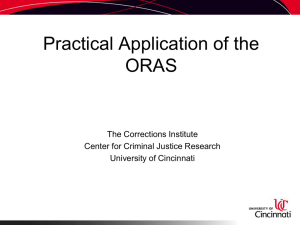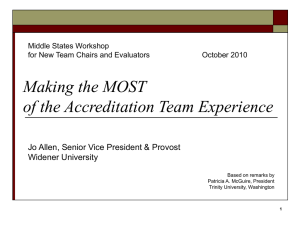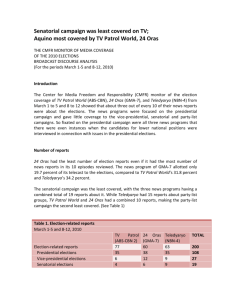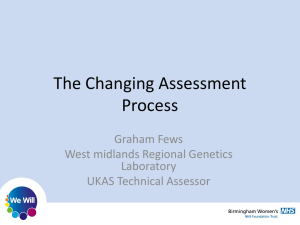Accurate-Assessments
advertisement
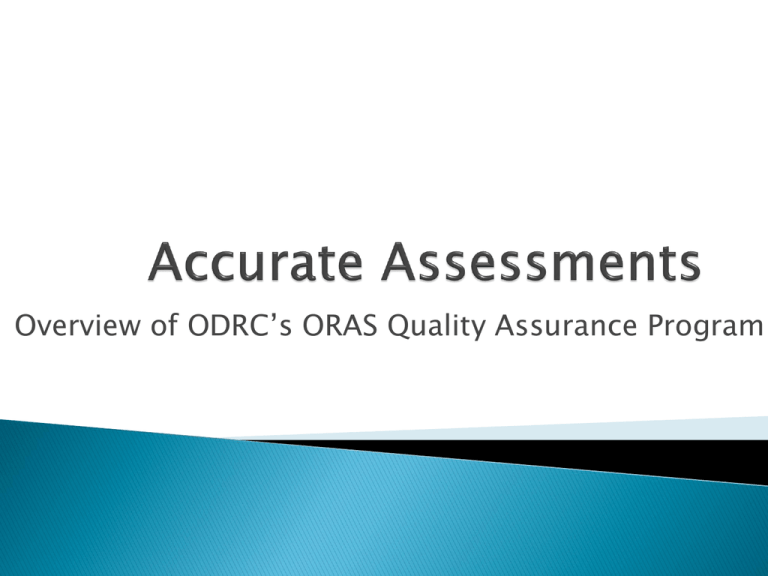
Overview of ODRC’s ORAS Quality Assurance Program What is Quality Assurance? ORAS File Review Development of the QA Program Results of the QA Program Recommendations A planned and systematic pattern of actions necessary to provide adequate confidence that the product optimally fulfills customer expectations. Proactive Improve Confidence Credibility Create a culture of quality Good fidelity = replication of results Mission “reduce recidivism” FAQ Flow charts Internal audit standards Quality Assurance Reports Case file reviews Quality Assurance Program Keep these 12 things clean for good assessments Duplicates Sources used Verifying collateral information Notes Pilot site evaluations Benchmarking Literature Review University of Cincinnati Goal = accurate assessments What contributes to the goal? ◦ Fidelity to the assessment process ◦ Good interview skills How will the QA program be delivered? ◦ Create measures/tools ◦ Timelines Implement the QA program Analyze and share results Evaluate program and make adjustments. QA Coordinator Random selection of staff Scheduling Communication Work flow Selection of Evaluators ORAS Direct Observation Tool Performance Measurement Guide Pre-brief meeting Direct Observation of the interview Individual Scoring of the tool Debrief and Coaching Results to the QA Coordinator Goals Program process Results End users All levels of management Subject matter experts/Certified ORAS Trainers IPC skills Recommendation from their immediate supervisor. Completion of evaluator training. Direct Observation Tool Performance Measurement Guide Double coding General process Common rating errors Providing good feedback that is balanced Giving and receiving criticism Survey Evaluation ◦ Evaluators (19) ◦ Assessors (116) ◦ Do survey results demonstrate gaps? Perceived value verses real value. Share results Value of the pre-brief meeting ◦ 65% of the assessors and 59% of the evaluators rated it successful or very successful. Concentrated areas of coaching ◦ Assessors and evaluators rated using the interview guide and using collateral information highest. Did assessors learn anything new? ◦ 61% of the assessors and 90% of the evaluators responded yes. Ability of the evaluators to add value ◦ 82% of the assessors rated the evaluators with the ability or strong ability to add value. How important are accurate ORAS assessments? ◦ 65% of the assessors rated it as important or very important. What are the barriers to completing accurate ORAS assessments? ◦ The length of time it tales to complete the interview and input the information into the portal. Also the program runs slow. ◦ Clients not being fully truthful. ◦ Not having an investigation in the file. ◦ Time consuming when you have a lot of other things to do. What was most valuable about the ORAS QA process? ◦ Getting reassurance that I was doing some things right. ◦ The tool has potential if done accurately. ◦ Helped understand my struggles were being felt by others also being evaluated. ◦ One on one discussion and feedback. ◦ Don’t think we need this, to concerned about QA and not the time consuming ORAS tool. How would you improve the ORAS QA process? ◦ It was fairly upfront and open. The evaluator did a good job with me. Maybe assess everyone at some point. ◦ I think the ORAS QA process can be very effective, if administered by someone that has actually completed an ORAS assessment of some kind. ◦ Have the assessor sit in on more than one assessment. ◦ Figure out a way across the state to bring all officers to the same page period. Good Luck! Interview Skills Reliability Direct Observation Tool Double Coding Survey Survey Trends Domains 6 and 7 Interview Skills Resources Subject Matter Experts Have a QA Coordinator Explain QA process to the offender Scoring Guide Have follow up plan ready to implement Staff support – supervisors need to be more knowledgeable. Sustainability Interview training Booster trainings focused on weak areas and/or changes RIB rules card Supervisor staffing requirements Individual Improvement Plan Consider assessor models Continue QA efforts statewide with all user groups Goals Concerns/barriers for staff Resources Process flow Direct Observation Training Communication Implementation Evaluation Follow up – use results to impact positive change Proactive Improve Confidence Credibility Deborah Herubin Deborah.Herubin@odrc.state.oh.us 614-995-0181 John Geras John.Geras@odrc.state.oh.us
